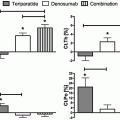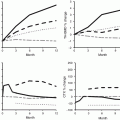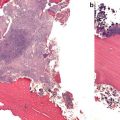Medication
Adverse event
Magnitude of association (from pooled analysis of clinical data)a
Bisphosphonates
Possible association with atypical subtrochanteric fractures of the femur
Not available—but the risk for this type of fracture is low
Data is inconsistent, but the US Food and Drug Administration has issued a boxed warning about this possible adverse effect
Alendronate
Mild upper GI eventsb
OR = 1.08,95 % CI: 1.01–1.15
Hypocalcaemia
9/301 treatment vs. 0/207 placebo
Zoledronic acid
Hypocalcaemia
OR = 7.22, 95 % CI: 1.81–42.7
Intravenous forms of zoledronic acid and ibandronate
Osteonecrosis of the jaw (ONJ)
Less than one case per 100,000 person-years of exposure (nearly all cases of ONJ are reported in people being treated for cancer)
Raloxifene
Pulmonary embolism
OR = 5.27, 95 % CI: 1.29–46.4
Thromboembolic events
OR = 1.63, 95 % CI: 1.36–1.98
Myalgias, cramps, and limb pain
OR = 1.53, 95 % CI: 1.29–1.81
Hot flashes
OR = 1.58, 95 % CI: 1.35–1.84
Menopausal hormone therapy: estrogen and estrogen–progestin combination
Cerebrovascular eventsc
Estrogen, OR = 1.34, 95 % CI: 1.07–1.68
Combination, OR = 2.27, 95 % CI: 1.05–1.57
Thromboembolic eventsc
Estrogen, OR = 1.36, 95 % CI: 1.01–1.86
Combination, OR = 2.27, 95 % CI: 1.72–3.02
Breast cancer
Estrogen: in the WHI [5], this hormone was associated with reduced incidence of breast cancer in women with hysterectomy when compared with placebo (HR = 0.77, 95 % CI: 0.62–0.95)d, but subgroup analysis noted that risk reduction was concentrated in women without benign breast disease or family history of breast cancer. No risk reduction was seen in women at high risk for breast cancer
Combination: in the WHI [15], estrogen–progestin was associated with more occurrences of invasive breast cancer than with placebo (HR = 1.25, 95 % CI: 1.07–1.46), tumors more likely to have lymph node metastases (HR = 1.96, 95 % CI: 1.00–4.04)e
Teriparatide
Hypercalcemia
OR = 12.9, 95 % CI: 10.49–16.0
Headaches
OR = 1.44, 95 % CI: 1.24–1.67
Denosumab
Mild upper GI eventsb
OR = 2.13, 95 % CI: 1.11–4.4
Rash
OR = 2.01, 95 % CI: 1.5–2.73
Infection
OR = 1.28, 95 % CI: 1.02–1.60
Medications | Adverse effect(s) |
|---|---|
Alendronate, risedronate, and ibandronate | Musculoskeletal pain Hypocalcemia Osteonecrosis of the jaw Severe irritation of upper gastrointestinal mucosa |
Zoledronic acid | Severe musculoskeletal pain Renal toxicity and acute renal failure |
Denosumab | Hypocalcemia Osteonecrosis of the jaw |
Teriparatide | Increased risk of bone cancer |
National Osteoporosis Foundation
The National Osteoporosis Foundation (NOF) focuses on patient and professional education, advocacy, and research in the United States. Their recommendations target both healthcare providers and individuals with osteoporosis and are based on FDA recommendations to regularly monitor patients and individualize treatment plans. NOF’s clinical guide to prevention and treatment of osteoporosis was updated in 2013 [34] and includes useful tools for clinicians on how to assess risk and when treatment should be indicated.
NOF Antiresorptive Therapy
Bisphosphonate medications have been known to involve adverse effects, most commonly gastrointestinal related. Unusually, there have been reports of bisphosphonate-related ONJ; however, ONJ risk in bisphosphonate-treated patients is unknown, and the risk appears to be low for at least up to 5 years of treatment [35]. The risk of ONJ also appears to increase in cancer patients receiving intravenous bisphosphonates. The NOF recommends that patients should speak to their doctors prior to discontinuing treatment. Atypical subtrochanteric and diaphyseal femoral fractures have been reported, although they are considered to be rare and associated with long-term use (>5 years). Symptoms of atypical subtrochanteric and diaphyseal femoral fractures include thigh and groin pain and should be reported immediately [35].
Alendronate has been approved by the FDA for the prevention and treatment of osteoporosis. It is recommended that patients receive 5 mg daily or 35 mg weekly for the prevention of osteoporosis and 10 mg daily (tablet) or 70 mg weekly (tablet) with 2800 IU or 5500 IU of vitamin D and 70 mg effervescent (tablet) for the treatment of osteoporosis. Alendronate has been shown to decrease the incidence of spine and hip fracture by 50 % and vertebral fracture by 48 % (without prior vertebral fracture) over 3 years [35].
Ibandronate has been approved by the FDA for the treatment of postmenopausal osteoporosis. The FDA recommends that patients receive a 150 mg monthly tablet and 3 mg every 3 months by intravenous injection. Ibandronate has shown to decrease the incidence of vertebral fractures by 50 % over 3 years; however, the reduction in risk of non-vertebral fracture has not been documented [36].
Risedronate is approved by the FDA for the prevention and treatment of osteoporosis in postmenopausal osteoporosis. It is recommended that patients receive 5 mg daily tablet, 35 mg weekly tablet, 35 mg weekly delayed release tablet, 35 mg weekly tablet packaged with six tablets of 500 mg calcium carbonate, 75 mg tablets on 2 consecutive days every month, or 150 mg monthly tablet. Risedronate has shown to reduce the incidence of vertebral fracture (41–49 %) and non-vertebral fracture (36 %) over 3 years [37].
Zoledronic acid has been approved for the treatment and prevention of osteoporosis in postmenopausal women, improved bone mass in men with osteoporosis, and for the prevention and treatment of osteoporosis for men and women expected to be on glucocorticoid therapy for at least 3 months. Zoledronic acid is administered intravenously for 15 min (5 mg) once a year for treatment and once every 2 years for prevention [38]. Zoledronic acid has been shown to reduce the incidence of vertebral fracture (70 %), hip fractures (41 %), and non-vertebral fractures (25 %) over 3 years [38]. Zoledronic acid can affect renal function and is contraindicated in patients with creatinine clearance less than 35 mL/min and with renal impairment [38]. Patients receiving zoledronic acid should be identified as at-risk and should have creatinine clearance monitored prior to each dose administered [38].
Estrogen (ET) and hormone therapy (HT) has been approved by the FDA for the prevention of osteoporosis. The Women’s Health Initiative (WHI) found that ET/HT has been proven to reduce the risk of vertebral and hip fracture (34 %) and other osteoporotic fractures (23 %) over 5 years [39]. The FDA recommends that ET/HT be used only to treat moderately severe menopausal symptoms, for the shortest time necessary; ET and HT should only be used for the prevention of osteoporosis, and approved non-estrogen treatments should be considered first [39].
Denosumab has been approved by the FDA for the treatment of postmenopausal women at high risk of fracture. Denosumab is administered by a health professional twice a year at a dosage of 60 mg. Denosumab has been proven to reduce the risk of vertebral fracture (68 %), hip fracture (40 %), and non-vertebral fracture (20 %) over the course of 3 years. However, it has also been associated with ONJ and atypical femur fractures [40, 41].
NOF Anabolic Therapy
Parathyroid hormone TPTD has been approved by the FDA for the treatment of osteoporosis in postmenopausal women, men at high risk for fracture, and patients at high risk of fracture with osteoporosis associated with sustained systemic glucocorticoid therapy [34]. It is recommended that patients are administered a daily injection of 20 μg daily. TPTD has shown to decrease the incidence of vertebral fractures (65 %) and non-vertebral fractures (53 %) following 18 months of therapy. TPTD is not recommended for patients at risk for osteosarcoma (including those with Paget’s disease, prior radiation of the skeleton, bone metastases, or hypocalcaemia) based on high osteosarcoma incidences identified in rat models. It is also recommended that patients do not receive TPTD treatment for more than 2 years and receive an antiresorptive agent such as a bisphosphonate to increase BMD [42].
Osteoporosis Canada
Osteoporosis Canada promotes osteoporosis risk reduction and treatment, providing medically accurate information to patients, healthcare professionals, and the public. The organization published guidelines in 2010, reviewing when osteoporosis pharmacotherapies including alendronate, risedronate, and zoledronic acid should be discontinued to prevent high-risk fracture in patients with osteoporosis [43]. According to Osteoporosis Canada, adverse events caused by bisphosphonates are considered to be rare, including ONJ and atypical fractures of the femur. The absolute risk of bisphosphonate-related ONJ is approximately 1 case per 100,000 person-years when bisphosphonates are administered for osteoporosis treatment [44]. The development of ONJ increases when individuals have poor oral hygiene and if oncology patients are receiving high-dose antiresorptive treatment. According to Osteoporosis Canada, little is known about features associated with atypical fractures of the femur. The absolute risk of bisphosphonate-associated atypical subtrochanteric diaphyseal femur fracture is between 2 and 78 cases per 100,000 persons [44]. However, while long-term clinical trial data has not shown an increase in atypical fracture of the femur risk, some studies have indicated that these trials are too small in nature to detect uncommon events [13, 44–46]. The most common bisphosphonate-associated with atypical femoral fractures is alendronate, likely due to its earlier availability relative to other currently used bisphosphonates.
Individuals at high risk for fracture are recommended to continue osteoporosis therapy without a drug holiday (Grade D evidence) as their anti-fracture benefits considerably outweigh potential for harm. This decision was based on rates of clinical vertebral fractures being reduced by 55 % for those who remained on alendronate therapy , compared to those who discontinued after 5 years in the FLEX trial [47]. High risk was identified as those over the age of 50 who had a prior fragility fracture of the hip or vertebrae, or those that suffered more than one fragility fracture , being offered a pharmacological therapy (Grade B evidence) or as greater than 20 % fracture probability, a major fracture probability over 10 years, using either FRAX or CAROC (Grade D evidence). Adverse effects were evidenced using Cochrane meta-analysis systematic reviews, as well as highlighting post-marketing surveillance [43].
A subsequent position statement on the duration of bisphosphonate use and drug holidays recommended that drug holidays should be considered for patients at low risk of fracture after 3–5 years of therapy with bisphosphonates [48]. For those at high risk of fracture with a history of fragility fracture or osteoporotic BMD, bisphosphonates should be continued without a drug holiday. A radiograph of the full length of the femur or a bone scan has been recommended for those with a history of thigh pain to assess for possible atypical subtrochanteric fractures [43]. Osteoporosis Canada findings and recommendations are in agreement with the ASBMR, FDA, and AHRQ.
Health Canada
Health Canada is the nation’s federal regulator of therapeutic drugs and provides public information on human pharmaceutical and biological drugs, veterinary drugs, and disinfectant products approved for use in Canada. The organization is in agreement with Osteoporosis Canada and has encouraged practicing clinicians to recognize that while the risk of adverse events is higher with bisphosphonate use, it remains minor and osteoporosis-related fracture prevention benefits outweigh ONJ and atypical femoral fracture risks [43, 44].
European Medicines Agency
The European Medicines Agency (EMA) conducts scientific evaluations and European public assessment reports (EPARs) of pharmaceuticals developed for use. Authorization assessments are conducted based on scientific criteria related to quality, safety, efficacy, and risk–benefit standards, and EPARs establish the scientific criteria based on which a pharmaceutical was granted authorization, as well as a detailed summary of product characteristics, labeling/packaging, and assessment and authorization procedural steps [49].
An increased risk of atypical fracture of the femur with little or no trauma was noted by the CHMP’s Pharmacovigilance Working Group in association with alendronic acid use in 2008, resulting in a warning addition to the product information of related medicines. The Working Group also decided to review this risk in other bisphosphonates (as a class effect) and identified published literature and post-marketing reports suggestive of atypical stress femoral fractures as a class effect by April 2010, leading to a further review by the CHMP to determine the need for regulatory action on bisphosphonate-containing medicines [50, 51].
The CHMP has examined all case reports, epidemiological studies, and other relevant data from published literature and industries relevant to bisphosphonate-related stress fractures. The optimal duration of bisphosphonate treatments has not been established by the EMA; the treatments have been recommended on a continual basis, with reevaluation of benefits and potential risks on an individual patient basis, particularly following 5 or more years of use [50, 51].
Authorized by the EU since April 15, 2005, zoledronic acid has been recommended as a single intravenous 5 mg infusion for osteoporosis in men at increased risk of fracture or with a recent low-trauma hip fracture, postmenopausal women, patients with long-term systemic glucocorticoid therapy, Paget’s disease of the bone patients, and low-trauma hip fracture patients (initiated 2 or more weeks following fracture repair) [52]. Zoledronic acid has been contraindicated in patients with creatinine clearance of <35 ml/min (severe renal impairment), hypersensitivity to bisphosphonates or the drug’s active substance, hypocalcaemia, and pregnant and breast-feeding women [52]. The HORIZON Pivotal Fracture Trial (n = 7736 postmenopausal women with osteoporosis) identified one case of ONJ in both intervention and placebo-controlled groups. Compared to placebo, zoledronic acid was found to significantly reduce the days of limited activity (p < 0.01) and the days of bed rest due to fractures (p < 0.01) [26]. Overall, adverse reactions have been reported by 44.7 %, 16.7 %, and 10.2 % of patients following first, second, and third infusions, respectively. Fever (17.1 %), myalgia (7.8 %), flu-like symptoms (6.7 %), arthralgia (4.8 %), and headaches (5.1 %) were commonly reported mild or moderate adverse effects, particularly within the first three days following administration [26, 52, 53]. An increased incidence of serious atrial fibrillation adverse events was also reported (51/3862 vs. 22/3852 placebo patients). Other common adverse events associated with zoledronic acid use include ocular hyperemia, dizziness, nausea, vomiting, diarrhea, bone pain, back pain, extremity pain, chills, fatigue, asthenia, general pain, malaise, infusion site reactions, and C-reactive protein increases [26, 52, 53].
Stay updated, free articles. Join our Telegram channel

Full access? Get Clinical Tree







